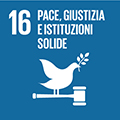- Docente: Lorenzo Zambernardi
- Crediti formativi: 8
- SSD: SPS/04
- Lingua di insegnamento: Italiano
- Modalità didattica: Convenzionale - Lezioni in presenza
- Campus: Forli
- Corso: Laurea Magistrale in Scienze internazionali e diplomatiche (cod. 9247)
-
dal 26/09/2023 al 12/12/2023
Conoscenze e abilità da conseguire
Obiettivo del corso è fornire una conoscenza avanzata delle principali teorie delle relazioni internazionali contemporanee (costruttivismo, liberalismo, realismo) con particolare riferimento alla sicurezza internazionale. Al termine del corso, lo studente conosce i principali dibattiti interni alla disciplina e le principali questioni di politica internazionale, avendo inoltre sviluppato la capacità di utilizzo degli strumenti analitici necessari per interpretare il funzionamento del sistema internazionale contemporaneo.
Contenuti
This course offers an introduction to the study of some of the major security issues in the contemporary world. In particular, it explores a series of empirical phenomena and themes in light of the most important concepts and theories in international relations theory. Students are expected to learn why countries go to war as well as why groups use terrorism. They will also acquire knowledge on nuclear proliferation, the prospects and pitfalls of military intervention, and on the role of technology and robotics (from nuclear weapons to unmanned drones) in threatening and strengthening the international order. At the end of the course, students are expected to understand the fundamental aspects and the distinctive elements of a variety of security issues in the current world. Finally, students will be able both to examine security threats and to devise the most appropriate policy response.
Testi/Bibliografia
Lezioni:
1) Introduction
- Simon Leys, 2013, "The Idea of the University", in S. Leys, The Hall of Uselessness, New York Review of Books, pp. 461-464.
- Lorenzo Zambernardi, 2016, “Politics is too important to be left to political scientists,” European Journal of International Relations, 22, 1, 3-23.
2) Security as a Multidimensional Concept
- Emma Rotschild, “What is Security?,” Daedalus, Vol. 124, No. 3, (Summer, 1995), pp. 53-98.
- John Mueller & Mark G. Stewart, “Terrorism and Bathtubs: Comparing and Assessing the Risks”, Terrorism and Political Violence, published online 28 December 2018.
3) Power Politics
- Tucidide, “Dialogo tra gli Ateniesi e i Meli,” La guerra del Peloponneso, V, 84-114.
- Machiavelli, Il Principe, any edition.
4) Inter-state conflicts I
- Geoffrey, Blaney, The Causes of War, New York, The Free Press, Ch. 8.
- Azar Gat , “The Changing Character of War”, in Hew Strachan and Sibylle Scheipers (eds) The Changing Character of War; available at http://www.oxfordscholarship.com.ezproxy.unibo.it/view/10.1093/acprof:osobl/9780199596737.001.0001/acprof-9780199596737-chapter-2
5) Inter-state conflicts II: the war in Ukraine
John J. Mearsheimer, "Why the Ukraine Crisis Is the West’s Fault", Foreign Affairs, 2014; dshttps://www.mearsheimer.com/wp-content/uploads/2019/06/Why-the-Ukraine-Crisis-Is.pdf.
John J. Mearsheimer, "Playing with Fire in Ukraine", Foreign Affairs, 2022.
6) Hegemonic rivalry
- Robert Gilpin, 1988, “The Theory of Hegemonic War,” Journal of Interdisciplinary History, 18, 4, 591-613.
- G. Allison, “The Thucydides Trap”, The Atlantic, September 24, 2015.
7) Nuclear weapons
8) The contemporary international system
Rodrik, Dani; Walt, Stephen M, "How to Build a Better Order: Limiting Great Power Rivalry in an Anarchic World", Foreign Affairs, Vol. 101, 5, (Sep/Oct 2022): 142-155.
John Mearsheimer, "Bound to Fail: The Rise and Fall of the Liberal International Order", International Security, Volume 43, Issue 4, Spring 2019, pp.7-50.
9) Armed Conflicts: nature, geography, and lethality
Davies, S., Pettersson, T., & Öberg, M. (2023). Organized violence 1989–2022, and the return of conflict between states. Journal of Peace Research, 60(4), 691-708.
10) Civil War I
- Francesco N. Moro "Civil Wars", in Paul Joseph ed., The SAGE Encyclopedia of War: Social Science Perspectives, Sage 2017.
- Stathis N. Kalyvas, “The Changing Character of Civil Wars, 1800–2009”, in Hew Strachan and Sibylle Scheipers (eds) The Changing Character of War, Ch. 11; available at http://www.oxfordscholarship.com.ezproxy.unibo.it/view/10.1093/acprof:osobl/9780199596737.001.0001/acprof-9780199596737-chapter-12
- Barbara F. Walter, The New New Civil Wars Annual Review of Political Science 2017 20:1, 469-486
11) Mid-Term
- No reading
12) Terrorism I
- The United States is a Leading Terrorist State: An Interview with Noam Chomsky. https://monthlyreview.org/2001/11/01/the-united-states-is-a-leading-terrorist-state/.
-D'Alema: "Definire i talebani terroristi è una stupidaggine", HuffPost, 11 settembre 2021; https://www.huffingtonpost.it/entry/dalema-definire-i-talebani-terroristi-e-una-stupidaggine_it_613c5fdde4b00ff836ecffa6.
- Alex Peter Schmid, “Terrorism: The Definitional Problem,” Case Western Journal of International Law, 36, 2, 2004, pp. 375-419
13) Terrorism II
- Andrew H. Kydd, Barbara F. Walter; The Strategies of Terrorism. International Security2006; 31 (1): 49–80.
- Erica Chenoweth, Terrorism and Democracy", Annual Review of Political Science 2013, 16:1, 355-378
14) Insurgency and COIN
- D., Galula, Counterinsuregency Warfare: Theory and Practice, Westport, Praeger, Ch. 1, 4, 5, 6, 7.
- Lorenzo Zambernardi, "Counterinsurgency's Impossible Trilemma", Washington Quarterly, 33, 3, pp. 21-34.
- A. Mack, "Why Big Nations Lose Small Wars", World Politics, 27, 2, 1975, pp. 175-200.
15) Drone warfaore
- G. Chamayou, Drone Theory, London, Penguin.
16) The longest war: the conflict in Afghanistan
- M. Barry, Kabul's Long Shadows: Historical Perspectives, Liechtenstein Institute at Princeton, 2011; available at http://www.operationspaix.net/DATA/DOCUMENT/4371~v~Kabuls_Long_Shadows__Historical_Perspectives.pdf
- Theo Farrell, ‘Unbeatable: Social Resources, Military Adaptation, and the Afghan Taliban [https://doi.org/10.15781/T22B8VW1N],’ Texas National Security Review, vol. 1, no. 3 (2018): 58-75.
17) The Erosion of Military Power
- E. Luard, The Blunted Sword, New York, New Amsterdam, 1988, pp. 1-24.
- Zambernardi, "Introduction" and "Epilogue"L. Life, Death, and the Western Way of War, Oxford, Oxford University Press.
18) Environmental security
- TBD
19) The current energy crisis, policies and solutions
- TBD
20) Final exam
- No reading
Metodi didattici
Lezioni frontali
Modalità di verifica e valutazione dell'apprendimento
Frequentanti: Due esami scritti in classe di 3 domande ciascuno.
Non frequentanti:
in presenza: scritto di alcune domande (dalle 5 alle 10 a seconda delle domande) e esame orale
Per i non-frequentanti alle letture sopra sarà aggiunto il seguente testo:
Zambernardi, L. 2022. Life, Death, and the Western Way of War (Oxford: Oxford University Press)
Strumenti a supporto della didattica
Power Point, Videos
Orario di ricevimento
Consulta il sito web di Lorenzo Zambernardi
SDGs




L'insegnamento contribuisce al perseguimento degli Obiettivi di Sviluppo Sostenibile dell'Agenda 2030 dell'ONU.
